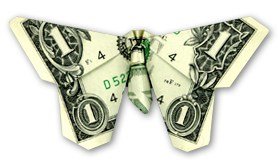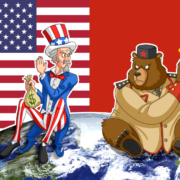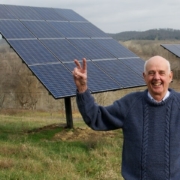The Financial Crisis Is the Environmental Crisis
by Eric Zencey
In May of 2009, U.S. federal legislation created the Financial Crisis Inquiry Commission, charged with investigating the causes of the financial crisis that led to the largest economic downturn since the Great Depression. The Commission’s report is due in January. But don’t get your hopes up; they’re more than likely to get it wrong.
The Commission has held hearings with and gathered testimony from quite a few experts, all of them entrenched within the mainstream of neoclassical economic theory. The experts have named the usual suspects: cyclical swings between greed and fear; feedback effects that “disequilibrate” markets; cheap and “poorly documented” mortgage financing; bank accounting that kept some liabilities “off balance sheet;” the international sale of debt that guaranteed that a collapse in one market in one country would ripple out to affect the world; foreign demand for American debt, which created demand-pull for riskier and riskier American investments; and unworkable hedge funds that appeared to transform sure-to-fail loans into sure-to-pay investments.
It’s likely that all of these played a role. Fixes for most of them ought to be undertaken on their own merits. (Who could be in favor of “poorly documented mortgages” or “off-balance-sheet” investments?) But none of the testimony makes this point: the financial crisis is also the environmental crisis. We won’t solve the former until we start solving the latter.
Two facts about this crisis stand out: the world came to the brink of global economic collapse, and the world is and remains on the brink of ecosystem collapse. The economy is humanity’s primary instrument for interacting with its environment; this suggests that these two facts are somehow related. And yet none of the standard diagnoses come anywhere close to acknowledging that there might be a connection, let alone start to illuminate it. In the standard view, the financial crisis beset an economy that consists solely of humans acting within formalized systems of their own creation —systems that have no connection to a larger world.
And that’s why the standard view won’t succeed in fixing the problem. The spasm of debt repudiation with which the crisis began — the collapse of the sub-prime lending market — is what happens when an infinite-growth economy runs into the limits of a finite world.
That insight comes from the reference frame suggested by Frederick Soddy, as elaborated by Nicholas Georgescu-Roegen, Herman Daly, and others. Soddy offered a vision of economics as rooted in physics — the laws of thermodynamics, in particular. An economy is often likened to a machine, though few economists follow the parallel to its logical conclusion: like any machine the economy must draw energy from outside itself. The first and second laws of thermodynamics forbid perpetual motion, schemes in which machines create energy out of nothing or recycle it forever. Soddy criticized the prevailing belief in the economy as a perpetual motion machine, capable of generating infinite wealth. That belief is nowhere more clearly manifest than in how we treat money. Soddy distinguished between wealth, virtual wealth, and debt. Real wealth, even the provision of services, is irreducibly rooted in physical reality. The money we use to represent this wealth isn’t real wealth, but virtual wealth — a symbol representing the bearer’s claim on an economy’s ability to generate real wealth. Debt, for its part, is a claim on the economy’s ability to generate wealth in the future. “The ruling passion of the age,” Soddy said, “is to convert wealth into debt” — to exchange a thing with present day real value (a thing that could be stolen, or broken, or rust or rot before you can manage to use it) for something immutable and unchanging, a claim on wealth that has yet to be made. Money facilitates the exchange; it is, Soddy said, “the nothing you get for something before you can get anything.”
Problems arise when wealth and debt are not kept in proper relation. The amount of wealth that an economy can create is limited by the amount of low-entropy materials and energy that it can sustainably suck from its environment and by the amount of high-entropy effluent that natural systems can sustainably absorb. (We can in practice exceed those sustainable limits, but only temporarily; that is the definition of “unsustainable.”)
There are only two ways that an economy can increase the rate at which it creates wealth: it can process a larger and larger flow of matter and energy, increasing its ecological footprint on both the uptake and the effluent side; or it can achieve efficiencies in its use of a constant flow of matter and energy. Both means of growth have limits. Increasing an economy’s ecological footprint decreases the ability of healthy ecosystems to provide us with a civilization-sustaining flow of ecosystem services (like climate stability, a service currently in critically short supply). Efficiency gains in the use of a constant flow offer large returns today and will probably do so into the future, but those gains will become harder and harder to achieve as we run into diminishing returns. Technological advances and efficiencies will allow us to make more with less, especially in places where we’ve been profligate in our use of low-entropy inputs; but no technical advance will get us around the first law of thermodynamics, which tells us “you can’t make something from nothing, nor can you make nothing from something.” Creation of wealth is irreducibly physical, and all physical phenomena obey the laws of thermodynamics.
Thus, the creation of wealth has physical constraints, set by ecosystem limits, physical law, and the limits of the technology we currently employ. But debt, being imaginary, has no such limit. It can grow infinitely, compounding at any rate we choose to let it.
These considerations led Soddy to this incontrovertible truth: whenever an economy allows debt — a claim on wealth — to grow faster than wealth can be created, that economy has a structural need for debt to be repudiated.
Inflation can do the job, decreasing debt gradually by eroding the purchasing power of the monetary units in which debt is denominated. And debt repudiation can be exported — some of the pressure to reconcile wealth and debt is released when other nations in the system inflate their currencies or default on obligations.
But when there is no inflation, and when the economy becomes one integrated global system in which export to outside the system is no longer possible, overgrown claims on future wealth will produce regular crises of debt repudiation — stock market crashes, waves of bankruptcies and foreclosures, defaults on bonds or loans or pension promises, the disappearance of paper assets in any shape or form. As Lawrence Summers noted in a speech last year at the Brookings Institute, “In little more than two decades, we have seen the stock market crash of 1987, the savings and loan scandals, the decline of the real estate market, the Mexican crisis, the Asian crisis, LTCM, Enron and long-term capital. That works out to one big crisis every two and a half years.” He went on to add: “We can and must do better.” Each and every one of the crises he listed was, at bottom, a crisis of debt repudiation. We are unlikely to avoid their recurrence until we stop allowing claims on real wealth to grow faster than real wealth can grow.
The cause of the financial crisis, Soddy would certainly say, isn’t simply opportunistic financiers exploiting the lag between innovation and regulation, isn’t simply ignorance, isn’t a failure of regulatory diligence, isn’t a cascading lack of confidence that could be solved with some new and different version of the F.D.I.C. The problem is a systemic flaw in our treatment of money. Whenever and wherever growth in claims on wealth outstrips growth in wealth, our system creates a niche for entrepreneurs who are all too willing to invent instruments of debt that will someday be repudiated. There will always be a Bernie Madoff or a subprime mortgage repackager or a hedge fund innovator willing to play their part in setting us up for a spasm of debt repudiation. Regulation will always be retrospective.
The best solution is to eliminate that niche. To do that, we must balance claims on future production of wealth with the economy’s power to produce that wealth.
Soddy distilled his vision into five policy prescriptions, each of which was taken at the time as evidence that his theories were unworkable. One: abandon the gold standard. Two: let international exchange rates float against one another. Three: use federal surpluses and deficits as macroeconomic policy tools, countering cyclical trends. Four: establish bureaus of economic analysis to produce statistics (including a consumer price index) that will facilitate this effort. These proposals are now firmly grounded in conventional practice. Only Soddy’s fifth proposal remains outside the bounds of conventional wisdom: stop banks from creating money, and debt, out of nothing.
Soddy’s work helped to inspire the short-lived “100% Money” movement that emerged during the Depression, which offered a diagnosis that went beyond treatment of symptoms (the cascading collapse of confidence that led to bank failures, which was addressed through creation of the F.D.I.C.) to reach the underlying cause: the leveraging of debt through the practice of fractional reserve banking. Irving Fisher at Yale and Frank Knight, the prominent Chicago School economist, also supported the elimination of fractional reserve banking. For a time the movement counted no less an economic eminence than Milton Friedman as a sympathizer. (Perhaps because he saw that the tide of history was against him, Friedman eventually dropped his call for elimination of fractional reserve banking from his policy recommendations.) The 100% money movement finds a contemporary advocate in ecological economist Herman Daly, who has called for the gradual institution of a 100 percent reserve requirement on demand deposits. This would begin to shrink what he has called “the enormous pyramid of debt that is precariously balanced atop the real economy, threatening to crash.”
In such a system, banks would support themselves by charging fees for safekeeping, check clearing, loan intermediation, and all the other legitimate financial services they provide. They would not generate income by lending out, at interest, the money entrusted to them for safekeeping — money that does not belong to them. Banks would still make loans and still be able to lend at interest “the real money of real depositors,” people who forego consumption today in order to take money out of their checking account and put it in time deposits (e.g., CDs, passbook savings, and 401Ks). In return these savers would still receive interest payments — a slightly larger claim on the real wealth of the community in the future.
In a 100% money system, every increase in spending by borrowers would have to be matched by an act of saving — abstinence — on the part of a depositor. This would re-establish a one-to-one correspondence between the real wealth of the community and the claims on that real wealth. To achieve 100% money, the creation of monetarized debt through other mechanisms — repackaged mortgages and securitized derivatives and the like — would also have to be brought under control.
An added benefit: establishing 100% money would have an enormous and positive effect on the public treasury. Seigniorage, the profit that comes from the creation of money, is currently given away free to banks (which collect it as the payment of interest and the repayment of principle on loans made with money that is not actually theirs). Under a 100% money regime, money would be created — spent into existence — by a public authority. (This is what Friedman advocated.) The capture of seigniorage would have obvious benefits for governmental budgeting: the seigniorage on a modest 3% growth in M1 (one of the chief measures of the money supply) amounts to $40 billion a year. And, when you come right down to it, to whom does seigniorage, by rights, belong? Despite long-standing custom to the contrary, the profit that comes from the issuance of money belongs to the sovereign power that guarantees that money. In the U.S., that’s us: We, the People.
This change in our banking system would eliminate the structural cause of spasms of debt repudiation. It would also eliminate one strong driver of uneconomic growth —growth that costs more in lost ecosystem services and other disamenities than it brings in the form of increased wealth. The change is thus economically and ecologically sound. It is, obviously, politically difficult — so difficult that advocacy for it sounds hopelessly unrealistic. But consider: in the 1920s, the abolition of the gold standard and the implementation of floating exchange rates sounded absurd. If the laws of thermodynamics are sturdy, and if Soddy’s analysis of their relevance to economic life is correct, we’d better expand the realm of what we think is realistic.







Thank you Eric for a well written article. I am thinking though that there may be an important implication of your arguments that could be pursued further. For the last six years, the world seems to have been having trouble growing it’s energy supplies. This has exasperated the divergence of real wealth from debt. While I agree with your arguments supporting a 100% money system, if world energy supplies should continue to fail to grow, or even begin declining as many analysts studying “Peak Oil” suggest, then these same laws of thermodynamics dictate that real wealth must also start declining. Fractional reserve financing or not, if you can’t get enough physical inputs, you’ll have trouble keeping what you’ve got, let along make more. Further, declining Energy Returned on Energy Invested will create positive financial feedback loops that sharpen the decline rate. Under these potential conditions, it seems to me that even more than adjustments to our financial systems, we will need adjustments to our cultural systems that permit us to be happy with less stuff rather than constantly seeking more. At it’s most fundamental, this is what is most at odds with our current economic system.
http://www.youtube.com/watch?v=RWsx1X8PV_A
Milton Friedman “DEFENDING GREED AS A SYSTEM OF ECONOMIC EFFICIENCY” in an old clip from 1979 / Phil Donahue interview.
Perhaps disturbingly fascinating, the Google search page airs this moment with open commentaries that claim the passage totally browbeat Donahue into submission with this absolutely malicious and self-aggrandizing distortion of historic revisionism. GREED IS GOOD comes back to haunt us on Wall Street but here is the devil’s apprentice himself laying it on the table in 1979.
http://search.aol.com/aol/search?invocationType=webmail-hawaii1-standardaol&query=milton%20Friedman%201979%20Phil%20Donahue%20interview%20%22GREED%22 ;
“NEO_CLASS ECONOMIA” and the mechanical environment are intermediaries of each other and operate through the displacement opportunities provided by the distinction between monetary accumulation and true asset building wealth. A “mutually assured production” policy is recyclable and sustainable; while the competitive exclusion progression is actually the political economy of a spiraling regressive return to smaller channels and class structured and fortified allocation. The results are not to include ecological constraints or environmental engineering to the problems nd crisis, but to utilize the crisis pressures to assert politico-military solutions that lock step us into path dependency progressions of desperation and retaliatory reciprocity. Milton Friedman, I’m afraid, would simply rationalize that the process will all balance out in the end. The monetarian utopia is one of denial across the spectrum for both the human and the ecological condition. The organic model is inefficient and the vitalistic or animistic model is non-realistic. The circular equivications of economic systematizing permitted the enlightened modern perspective to separate human history from human nature and civilization from the ecological awareness of its environment. We are what we produce. Now the neo-realists have taken this schizoid fracture into the rhelm of the borderline personality cult of composition and proclaim that “game theories” prevail while we create the structure of existential reality ad hoc from our own superficial choices: now actually denying HISTORY itself. Twice separated from foundation, it is futile to expect the truth in discoveries or a continuous learning system of steady state foundation. We ARE the light and there is no room for truth in the factoid fiction of our survivalist realities. And we certainly will see no exudus from the cash register mentality of market economics and the feeding frenzies of “monetary exclusion” in this operational realism of today.
Great essay, thanks.
When faced with the unhappy dilemma of choosing between a physical and a political impossibility, it is better to attempt the politically “impossible”.
—Daly and Farley, Ecological Economics (2011)
http://www.tvburkey.org/MyQuotesCollection.htm#OnEconomics
Your piece is rock solid until you opine the following blunder.
“If the laws of thermodynamics are sturdy, and if Soddy’s analysis of their relevance to economic life is correct, we’d better expand the realm of what we think is realistic.”
More than nit; If you know any laws that are more sturdy than thermo, please let us in on it.
IF YOU can make such an egregious scientific error, imagine what problems of scientific understanding arise from less informed struggling pilgrims.
Is “spezio” somehow related to “specious?” What an absurd criticism of the author’s concluding remark–an obvious rhetorical device here treated at face value. When someone writes, “If the speed of light is constant, then [etc.],” no educated reader thinks, “Oh mon dieu! The author questions the speed of light as constant??” To suggest that the author’s statement is “egregious scientific error” is, itself, egregious and witting obtuseness.
Thanks for this piece. It would have helped if you had mention from the start when Soddy lived.
Outstanding piece … A superb explanation of why fractional reserve banking aka debt leveraged currency and credit, is the primary culprit of our current situation financially, environmentally and politically.
What should also be apparent is that capitalism and fractional reserve banking are two very different animals that are always conflated together. This is by design.
The banksters political power will always seek to confuse these two different mechanisms for their own privilege and profit at the expense of the Commonweal.
How would you suggest eliminating the fractional reserve requirement, leaving aside the question of political impossibility? Is it something that flows out of Federal Reserve requirements? Congressional legislation?
Thanks. You’ve really compressed some basic ecological economics issues into a very concise article. I like the way you put the issue of how it is possible for an economy to increase the rate at which it produces wealth: through increased use of resources (greater ecological footprint) or through efficiency.
It might interest everyone to know that this article is attracting interest on Gail Tverberg’s blog, “Our Finite World.” Here’s the link:
http://ourfiniteworld.com/2011/01/06/the-oil-employment-link-part-2-looking-at-more-detail-underlying-history-chanels-prophets-of-doom-story/
(Scroll down to the comment by Jerry McManus and her reply.)
She says that your article is basically good, but asks what is going to happen with all this debt that we have in our current system?
There’s about $50 trillion in U. S. debt (mostly private debt, business loans, etc.) right now. Will we just let all of these debts default, or what, if we go to 100% reserve requirement? A few people will be able to repay their loans under such a regimen, but a hefty percentage will probably not be. Won’t this lead to bank failures, credit seize-up, etc.? I’d be interested to see if you had any comments to make on either forum.
Keith
Good post until you get into fractional reserve banking and a 100% reserve requirement. You are assuming that banks lend reserves or against reserves. This is incorrect since the US went to a nonconvertible floating rate currency, when the money supply became endogenous.
Banks lend against capital, that is, put capital at risk. Banks are not reserve constrained, since the Fed always provides reserves at a price as the lender of last resort. The reserve requirement only affects cost, not availability. Raising the reserve requirement would make loans more expensive, but it would not limit lending.
Banks are capital constrained. If you want to limit lending, then increasing the capital requirement is the way to go. What you mean is a 100% capital requirement rather than a 100% reserve requirement.
See, for example, Bill Mitchell on 100% reserve banking.
http://bilbo.economicoutlook.net/blog/?p=7299
This is greatly elaborated in the comments to Bill’s post, especially by experts like JKH and Scott Fullwiler.
Me, too. Great piece.
However, good luck in achieving change at the national policy level first of all. I don´t think the cultural “entropy” in terms of energy required will flow that way, at first anyway. First though, I´d like to note that William Greider´s articles in the Nation and a series of New York Times articles tracked the specific legislation and other legislative-political maneuvers that are so glibly rationalized as “poorly documented mortgages” or “off-balance-sheet” investments.”
see, for example,
W. Greider, “Establishment Disorder,” The Nation, Oct. 29, 2008;
P. S. Goodman, “The Reckoning: Taking a Hard New Look at a Greenspan Legacy,” The New York Times, Oct. 8, 2008;
F. Partnoy, “Danger in Wall St.´s Shadows,” The New York Times, May 15, 2009;
D. Leonhardt, “Reconsideration: Washington’s Invisible Hand,” The New York Times, Sept. 26, 2008
Meanwhile, reorienting our own consumer and producer choices to support alternative business practices is the practical foundation of recommendations to achieve macro policies with common sense. The U.S. Riegle Community Development and Regulatory Improvement Act of 1994 is an interesting piece of legislation to consider, though, from the policy perspective. The Federal Financial Institutions Examinations Council, http://www.ffiec.gov/Riegle.htm, is evaluating progress, and a fund site corresponds to the law´s provisions Community Development Fund Initiative Fund, http://www.cdfifund.gov/who_we_are/about_us.asp.
At the same time, we´ve got lots of food for thought in the credit union and co-op banking sectors. In Europe, co-op banks already have 20% of the market, for one thing. Ralph Nader wrote an interesting piece in Counterpunch on credit unions and the crisis.
Also, let´s not forget ShoreBank Pacific´s Ecodeposits program.
Best regards to Casse, and all.